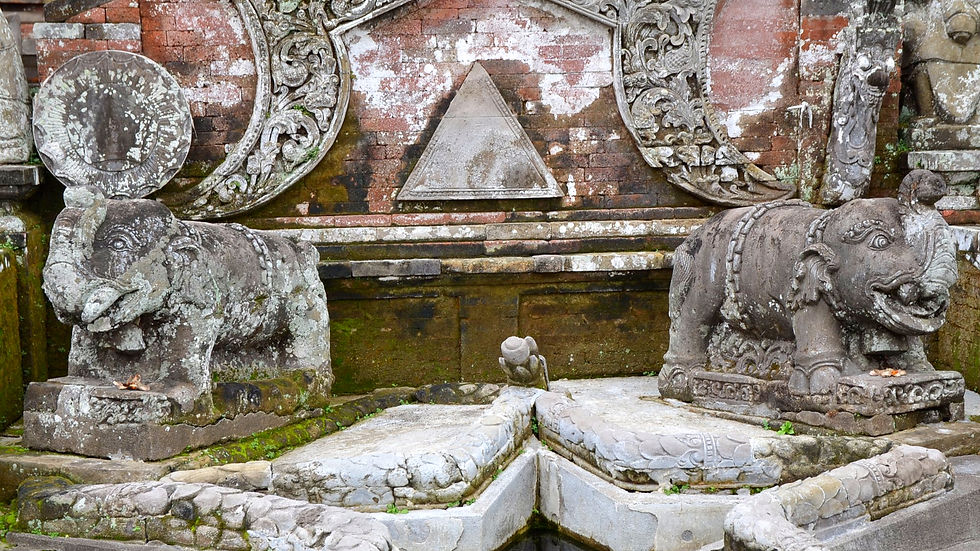The Moon of Pejeng - Temple of the Bronze Drum
- Shannon
- Sep 18
- 3 min read
The Legacy of Pura Penataran Sasih
Pura Penataran Sasih is a temple of profound historical and spiritual importance, its origins traced through ancient Sanskrit inscriptions carved into its towering split gateway. Established in 1266 AD, it once functioned as the state temple of the Pejeng kingdom, playing a central role in the region’s religious and political life. Set within the fertile Petauan River valley, an area instrumental to the development of Bali’s intricate rice cultivation systems, the temple reflects the enduring connection between sacred ritual, agriculture and the rhythms of the land.

At the heart of the temple lies the world famous Pejeng Moon, a colossal, 2000 year old bronze drum known as a Nekara. Measuring approximately 186.6 centimeters in height and nearly two metres in length, it is believed to be the largest single piece bronze cast drum in the world. This monumental artefact is thought to date back to the 3rd century BC, originating from the Dong Son culture of northern Vietnam. The intricate geometric patterns that decorate the drum resemble designs found across Southeast Asia, from Vietnam and China to Papua, suggesting a rich history of ancient trade, craftsmanship and cultural exchange.

The Pejeng Moon carries immense mythological and ritual significance. Balinese legend tells that the drum was once a wheel of the chariot that carried the moon across the night sky. It fell from the heavens, landing atop a tree in Pejeng, shining so brightly that it deterred thieves. One attempted to extinguish its light by urinating on it, causing the moon to explode and fall to Earth as the drum. The thief paid for his desecration with his life. Locally, the drum is closely associated with Dewi Ratih, the Hindu Lunar Goddess and is still used in ceremonies to invoke rain and peace, its deep resonant sound likened to a lightning strike.

Colour symbolism plays a significant role in Balinese culture, where yellow, often seen in the temples offerings and decorations, represents happiness, peace, meditation and mental development. This deep connection between colour, tradition and spiritual belief is embodied at Pura Penataran Sasih, particularly through the sacred Moon of Pejeng, which continues to serve as a powerful symbol of reverence and artistic expression.

The temple complex itself is rich with sacred art and ancient relics. Besides housing the Pejeng Moon in a special pavilion within the central courtyard, Pura Penataran Sasih features numerous shrines and statues, including depictions of Ganesha, other Balinese Hindu gods and goddesses and guardian figures like Dwarapala. The presence of Lingga and Yoni sculptures symbolises fertility and the union of masculine and feminine energies. Additionally, stone inscriptions in both Kawi and Sanskrit, though weathered and partially illegible, date back to as early as the 9th or 10th century, testifying to the areas longstanding religious and cultural heritage.
Architecturally, the temple is divided into several sections, including the northern temples Bale Agung, Taman Sari and Ratu Pasek, with the Mother Temple located to the south. Four palebaan (pavilions) accompany the main temple, enhancing the spiritual landscape. Visitors entering through gates guarded by statues of elephants and dragons are greeted by a site that serves both as a place of worship for practicing Hindus and as a treasure trove for archaeologists fascinated by its Bronze Age legacy.
During religious festivals, the temple comes alive with sacred ceremonies such as the Sang Hyang Jaran dance, further highlighting its enduring role in Bali’s spiritual life. As both a cultural heritage site and an active place of worship, Pura Penataran Sasih offers visitors an unparalleled glimpse into the island’s Bronze Age past, its mythic legends and its vibrant present day traditions.

🗺️ Location
Jalan Raya Tampaksiring, Pejeng, Tampaksiring, Kabupaten Gianyar, Bali, Indonesia
🚆 How to get there
If you don’t ride a bike, a driver can include a visit to this temple into a full day itinerary.
⭐ Attraction Info
Despite housing the largest single cast bronze drum in the world and one of Southeast Asia’s most important Bronze Age relics, Pura Penataran Sasih remains surprisingly off the radar for most tourists. Tucked away in the village of Pejeng, the temple is quiet and peaceful, rarely appearing on mainstream Bali itineraries and is best visited only if you’re already in the Ubud or Pejeng area. A visit typically takes no more than 20 to 30 minutes, with entry costing 20,000 IDR and it’s open daily between 7am - 5pm. The site offers little in the way of signage or interpretation, so it’s best appreciated by those with prior knowledge or a guide. Still a traditional place of worship, Pura Penataran Sasih requires all visitors to wear a sarong, ensuring knees, ankles, shoulders and midriffs are respectfully covered. Make sure to bring one with you.
Thanks for reading about The Moon of Pejeng - Temple of the Bronze Drum. Check out more awesome destinations here!
The Temple of the Bronze Drum - Known as the Moon of Pejeng in Bali

\

























